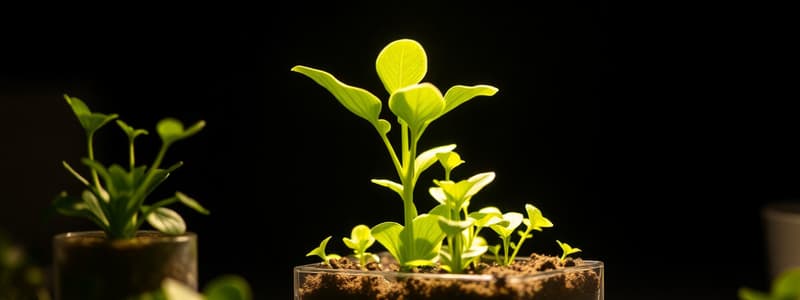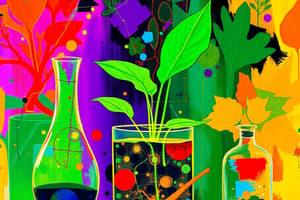Podcast
Questions and Answers
What processes lead to the formation of fossil fuels?
What processes lead to the formation of fossil fuels?
- Fermentation of plant materials in open air
- High pressure and temperature acting on dead organisms in low-oxygen areas (correct)
- Immediate breakdown of organic matter by scavengers
- Rapid decomposition of organisms in oxygen-rich environments
Which fossil fuel is primarily formed from the remains of tiny marine organisms?
Which fossil fuel is primarily formed from the remains of tiny marine organisms?
- Peat
- Coal
- Charcoal
- Natural gas (correct)
What is the primary use of coal extracted from the ground?
What is the primary use of coal extracted from the ground?
- Producing natural gas
- Carbon capture storage
- Generates electricity in power stations (correct)
- Converting to petroleum for transport
What happens when fossil fuels are burned?
What happens when fossil fuels are burned?
How long does the process of turning dead organisms into fossil fuels typically take?
How long does the process of turning dead organisms into fossil fuels typically take?
What is the primary substance that plants store carbohydrates as?
What is the primary substance that plants store carbohydrates as?
In which part of the plant cell is starch stored?
In which part of the plant cell is starch stored?
What is the purpose of the iodine test in the context of photosynthesis?
What is the purpose of the iodine test in the context of photosynthesis?
What is the first step in preparing a leaf for the iodine test?
What is the first step in preparing a leaf for the iodine test?
Why is it important to turn off the burner before using ethanol in the experiment?
Why is it important to turn off the burner before using ethanol in the experiment?
What color should you expect to see dissolved in ethanol when chlorophyll is extracted from a leaf?
What color should you expect to see dissolved in ethanol when chlorophyll is extracted from a leaf?
What safety measure is recommended while performing the leaf testing experiment?
What safety measure is recommended while performing the leaf testing experiment?
What should be monitored while heating ethanol in the experiment?
What should be monitored while heating ethanol in the experiment?
What is the first step you should take in the experiment when bubbles are observed?
What is the first step you should take in the experiment when bubbles are observed?
What should you do after counting the number of bubbles for the first time?
What should you do after counting the number of bubbles for the first time?
How should you display the results of your experiment?
How should you display the results of your experiment?
Which of the following best explains what light intensity refers to in this experiment?
Which of the following best explains what light intensity refers to in this experiment?
What is the expected trend when the distance of the lamp from the test tube increases?
What is the expected trend when the distance of the lamp from the test tube increases?
What is the primary purpose of exchanging results charts with a partner?
What is the primary purpose of exchanging results charts with a partner?
When plotting the graph, what should be included on the horizontal axis?
When plotting the graph, what should be included on the horizontal axis?
What should be stated in the conclusion concerning light intensity and photosynthesis?
What should be stated in the conclusion concerning light intensity and photosynthesis?
What factor primarily contributes to the increase in sea level due to rising temperatures?
What factor primarily contributes to the increase in sea level due to rising temperatures?
What is the estimated rise in sea level by the end of this century?
What is the estimated rise in sea level by the end of this century?
Which cities are mentioned as particularly vulnerable to sea level rise?
Which cities are mentioned as particularly vulnerable to sea level rise?
How do droughts contribute to the risk of wildfires?
How do droughts contribute to the risk of wildfires?
What aspect of glaciers is highlighted concerning rising temperatures?
What aspect of glaciers is highlighted concerning rising temperatures?
What should you ensure about the water before beginning the experiment?
What should you ensure about the water before beginning the experiment?
What is the first step in the method for conducting the experiment?
What is the first step in the method for conducting the experiment?
Which of the following apparatus is necessary for the experiment?
Which of the following apparatus is necessary for the experiment?
What will happen when the lamp is placed close to the conical flask?
What will happen when the lamp is placed close to the conical flask?
What should you record on the results chart during the experiment?
What should you record on the results chart during the experiment?
Flashcards are hidden until you start studying
Study Notes
Photosynthesis Experiment
- Place a plant in a test tube of water and ensure bubbles are coming from the cut end of the plant stem.
- Measure the distance between a lamp and the test tube to set up an experiment.
- Count the number of bubbles produced by the plant per minute.
- Repeat the bubble count three times.
- Move the lamp further from the test tube, measure the new distance, and repeat the bubble count.
- Continue increasing the distance of the lamp from the test tube and recording the bubble count.
- Calculate the average number of bubbles produced for each distance.
- Plot a graph with the distance of the lamp from the test tube on the horizontal axis, and the average number of bubbles on the vertical axis.
- As the distance of the lamp from the test tube increases, the light intensity decreases.
- As the light intensity increases, the rate of photosynthesis increases.
Testing Leaves for Starch
- Boil a leaf in water to break down cell walls.
- Transfer the leaf to ethanol to remove chlorophyll (the green pigment).
- Heat the ethanol carefully to expedite the removal of chlorophyll from the leaf.
Fossil Fuels
- When organisms die, their remains may be buried under sediment in oxygen-free environments like peat bogs or deep ocean floors.
- Over time, these remains are transformed by high pressure and heat into fossil fuels such as coal, oil, and natural gas.
- Plants decomposing in swamps form coal over millions of years.
- Fossil fuels contain carbon from the carbohydrates, fats, and proteins of the original organisms.
- Burning fossil fuels releases carbon dioxide into the atmosphere.
The Carbon Cycle
- The formation and combustion of fossil fuels are key components of the carbon cycle.
- The carbon cycle involves the movement of carbon through the environment via photosynthesis, respiration, decomposition, and the burning of fossil fuels.
Global Warming and Sea Levels
- Rising global temperatures contribute to sea level rise.
- Warmer water expands, leading to increased sea levels.
- Melting glaciers and ice caps add additional water to the oceans.
- Sea level has been rising at a rate of about 3 mm per year.
- Scientists estimate that over 600 million people are at risk from flooding due to rising sea levels by the end of this century.
- Coastal megacities such as Shanghai, Mumbai, and Los Angeles are particularly vulnerable.
Experiment: The Effects of Temperature on Sea Level
- Cool water and ice cubes are used to simulate a change in the level of the ocean.
- Fill two measuring cylinders to the same level with cool water and ice cubes.
- The ice is allowed to melt in both cylinders.
- One cylinder has ice in a funnel while the other does not.
- The changes in water levels are observed and recorded.
- This experiment demonstrates the link between rising temperatures and changes in water levels.
Studying That Suits You
Use AI to generate personalized quizzes and flashcards to suit your learning preferences.




